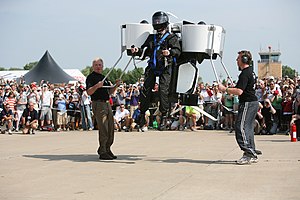Fan pack
| Martin Jetpack | |
|---|---|
 |
|
| The Martin Jetpack flying at AirVenture 2008. | |
| Role | Ultralight aircraft |
| National origin | New Zealand |
| Manufacturer | Martin Aircraft Co. |
| Designer | Glenn Martin |
| Introduction | 2008 |
| Status | Not ready |
| Unit cost | |
The Martin Jetpack is a single-person aircraft under development after 30 years of work. Despite its name, it does not use a jet pack as such, but ducted fans for lift. Martin Aircraft Company of New Zealand (not related to Glenn L. Martin Company, the US company also known as Martin Aircraft) developed it, and they unveiled it on 29 July 2008, at the Experimental Aircraft Association's 2008 AirVenture in Oshkosh, Wisconsin, US. The US Federal Aviation Administration classified it as an experimental ultralight airplane.
It uses a gasoline (petrol) engine with two ducted fans to provide lift. It is specified to have a maximum speed of 40 km/h, a flight ceiling of 2,500 ft, a range of 15–20 km and endurance of about 28 minutes flight. Empty weight is 200 kg. The first customers are said to be first responders.
The Martin Jetpack has been under development for over 30 years. Glenn Neal Martin (not Glenn L. Martin, of US Martin Aircraft) started work on it in his Christchurch garage in the 1980s.
New Zealand aviation regulatory authorities approved the Martin Jetpack for a limited set of manned flight tests in 2013. As of 2016 the price of the commercial production units is expected to be US$250,000 and sell in the US for US$250,000-350,000 subject to local tax and customization requirements.
Glenn Martin suddenly resigned on 4 June 2015 after investing 30 years in the product. He says now he can spend more time with his family and has other business projects. His concluding statement was, "I only have two pieces of advice. Deliver the dream that people want, not the product that is easiest to build. Now don't f... it up!"
In August 2016 CEO Pete Coker was replaced by the former CFO James West.
The Martin Jetpack is a small VTOL device with two ducted fans that provide lift and a 2.0-litre V4 piston 200-horsepower gasoline engine. Although its pilot straps onto it and does not sit, the device cannot be classed as a backpack device because it is too large to be worn while walking. Although the Martin Jetpack does not meet the Federal Aviation Administration's classification of an ultralight aircraft: it meets weight and fuel restrictions, but it cannot meet the power-off stall speed requirement. The intention is to create a specific classification for the jetpack - it uses the same petrol used in cars, is relatively easy to fly, and is cheaper to maintain and operate than other ultralight aircraft. Most helicopters require a tail rotor to counteract the rotor torque, which, along with the articulated head complicate flying, construction, and maintenance enormously. The Martin Jetpack is designed to be torque neutral – it has no tail rotor, no collective, no articulating or foot pedals – and this design simplifies flying dramatically. Pitch, roll and yaw are controlled by one hand, height by the other.
...
Wikipedia
